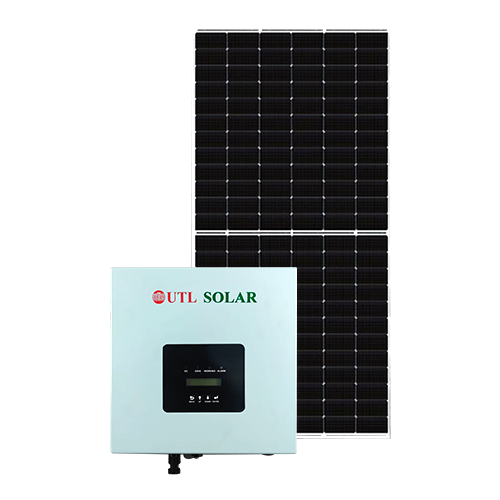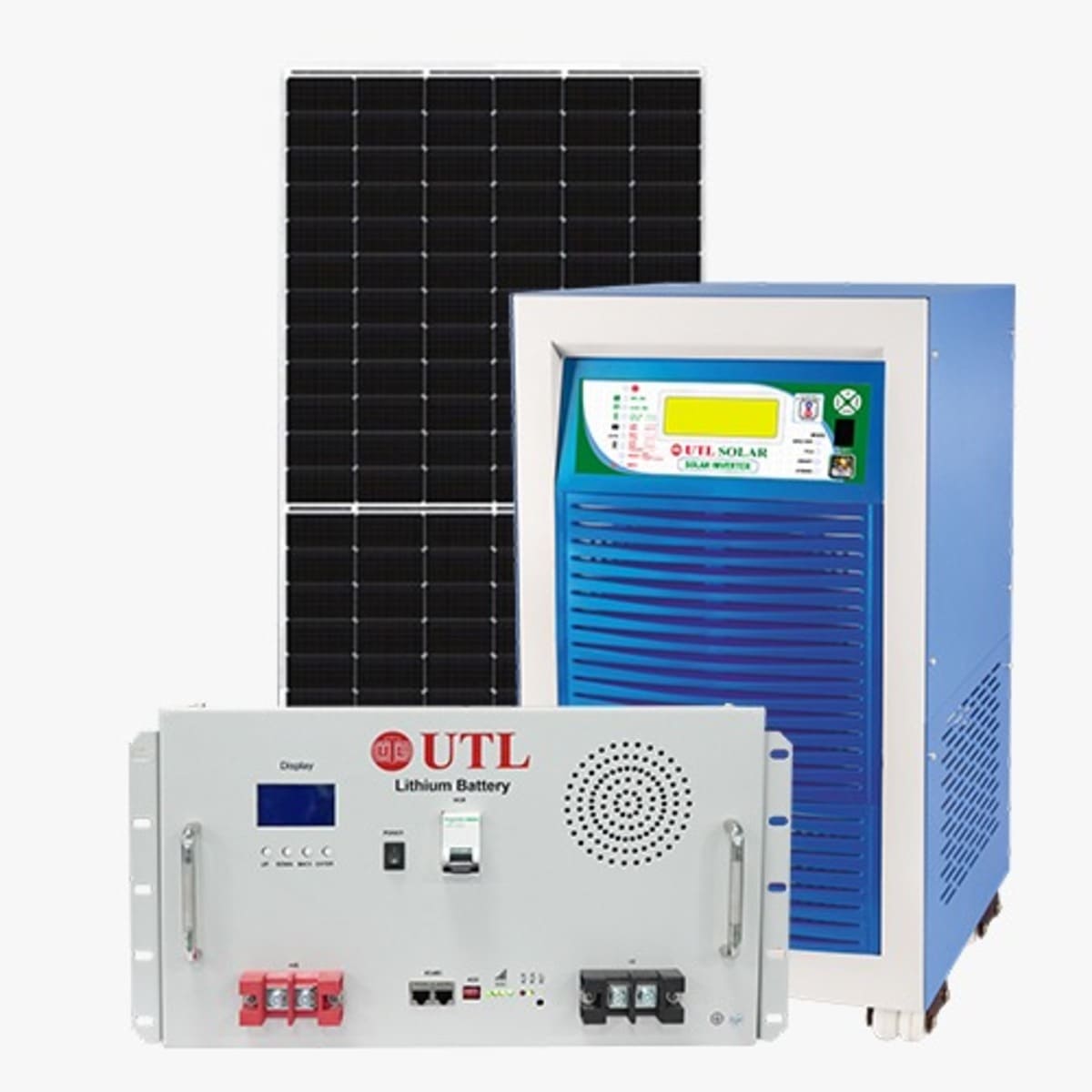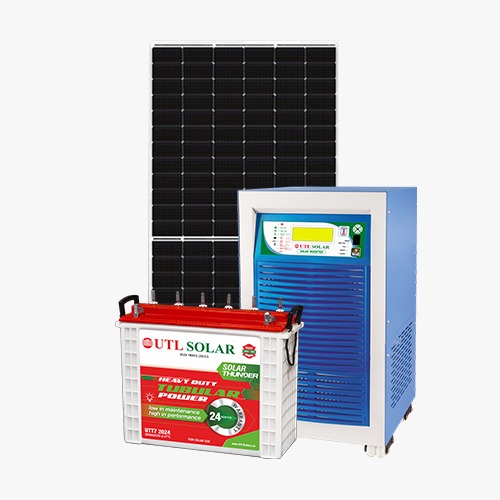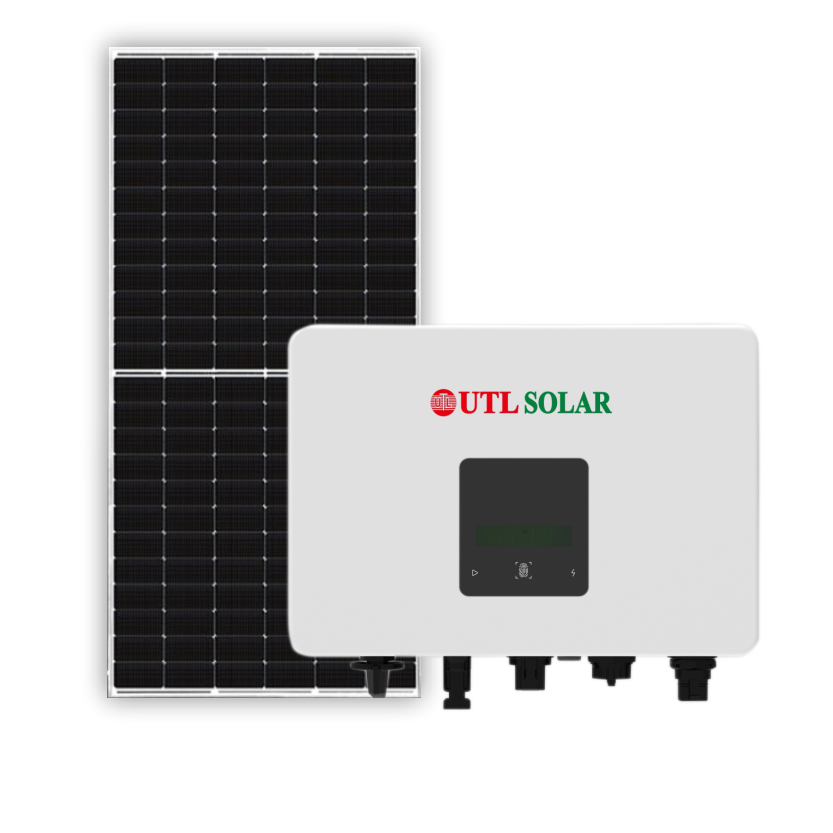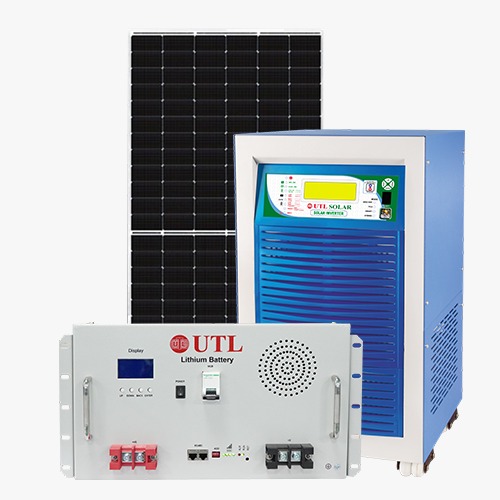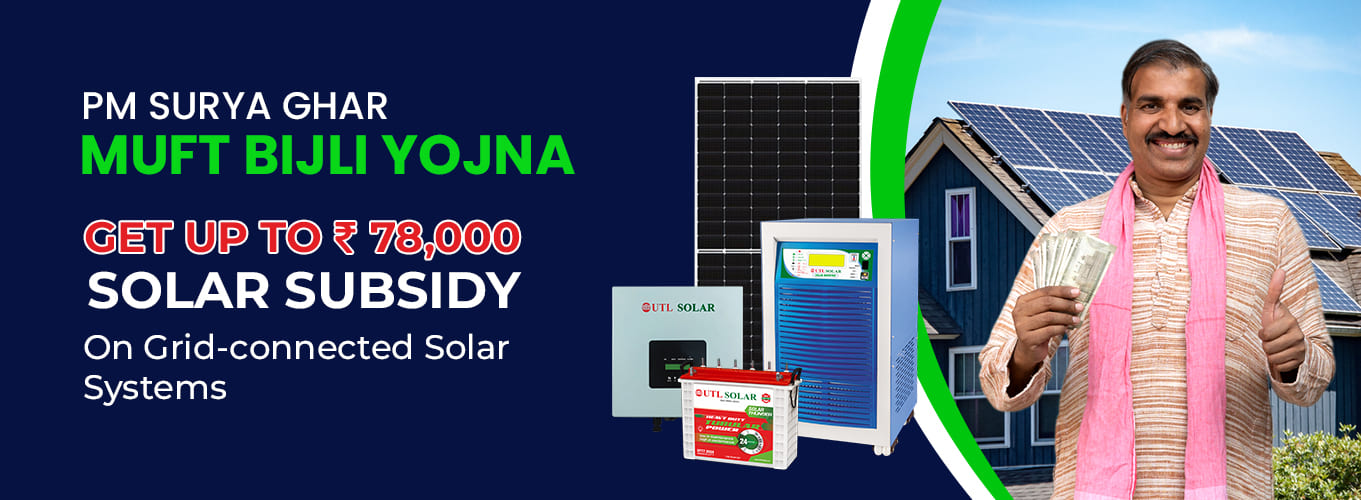
Ultimate Guide for Rooftop Solar Panel Subsidy
Are you looking to slash your electricity bills, contribute to a greener planet, and take advantage of the government solar subsidy scheme? You’re in the right place. With the PM Surya Ghar: Muft Bijli Yojana, eligible households in India can now receive a solar panel subsidy of up to ₹78,000 on installing grid-connected rooftop solar systems. In this guide, we break down everything you need to know — from eligibility and system selection to the application process and other critical details. Whether you’re new to solar or already comparing vendors, this blog has everything you need to make an informed decision.
What Is the PM Surya Ghar: Muft Bijli Yojana?
Pradhan Mantri Surya Ghar Yojna is a Government of India initiative that aims to empower 1 crore households by offering up to 300 units of free electricity per month through rooftop solar systems. To encourage adoption, the scheme offers a direct subsidy to homeowners opting for grid-connected or hybrid rooftop solar PV systems — helping= lower the upfront cost significantly.
How Much Subsidy Can You Get?
Here’s the current subsidy structure for residential households:
| System Capacity | Subsidy Amount |
| Up to 2 kW | ₹30,000 per kW |
| 2 kW to 3 kW | ₹18,000 per kW (for extra kW) |
| Maximum Subsidy | ₹78,000 (for extra kW) |
So, for a 3kW system, you get:
- ₹30,000 x 2 kW = ₹60,000
- ₹18,000 x 1 kW = ₹18,000
- Total Subsidy: ₹78,000
Note: Systems above 3 kW are eligible, but the maximum subsidy remains capped at ₹78,000.
Additional Benefits for Group Housing Societies (GHS) & RWAs
- Subsidy of ₹18,000 per kW for systems up to 500 kW
- Capacity calculated at a max of 3 kW per household
- Ideal for common areas, lighting, and EV charging stations
Rooftop Solar Subsidy Support from State Government
Alongside central assistance, many Indian states offer their own subsidies or incentives to support rooftop solar adoption. These state-level benefits vary based on location, consumer category, and system size. Here’s a quick look at what different states are offering to residential consumers.
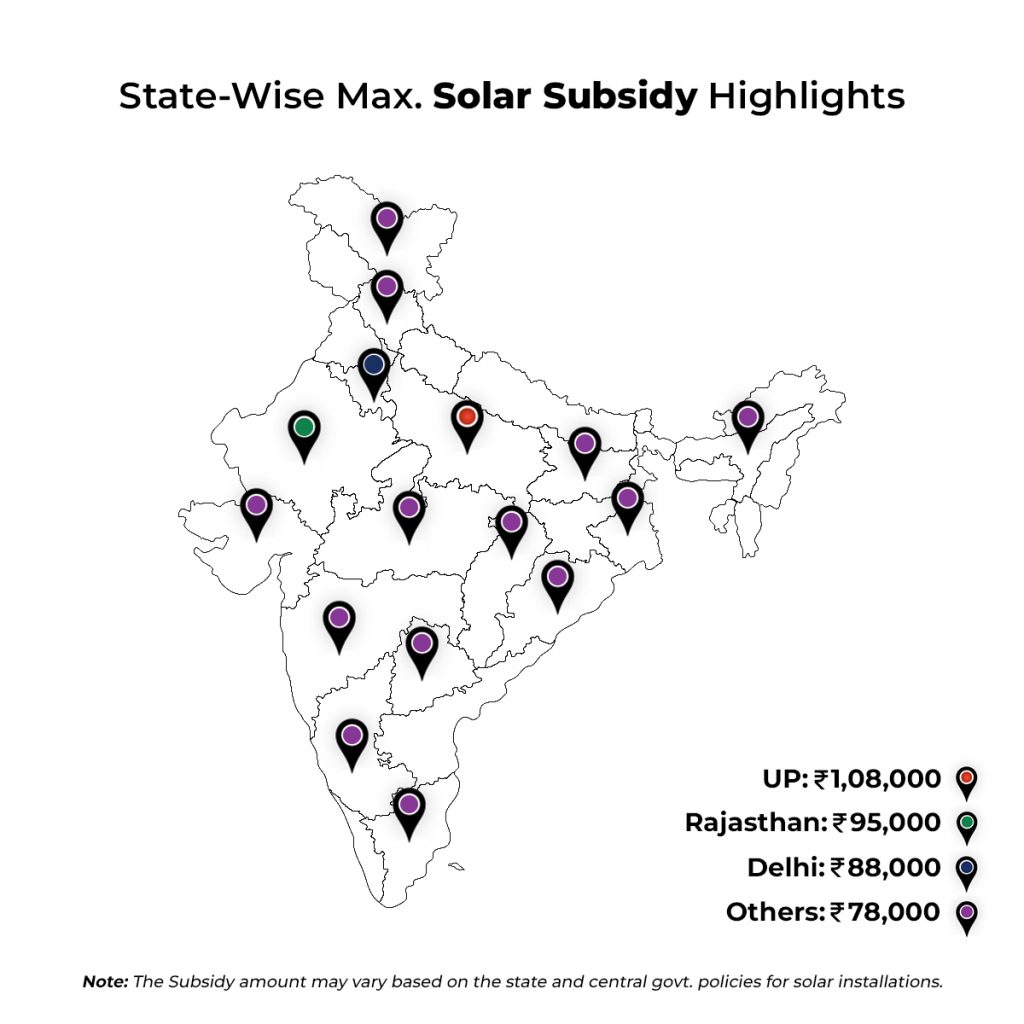
Uttar Pradesh
Apart from the central subsidy support, Uttar Pradesh state government offers a subsidy of ₹15,000 per kW (up to ₹30,000 per home) for grid connected residential rooftop solar systems in UP. This benefit is provided on a reimbursement basis and will be released after the solar system is successfully installed, commissioned, and all necessary documentation is submitted to the State Nodal Agency (UPNEDA).
Rajasthan
Under the central government’s scheme (MNREGA), eligible homeowners can receive a subsidy of up to ₹78,000. In addition, the Rajasthan Government provides a state subsidy of ₹17,000 for systems above 1.1 kW, but this is limited to beneficiaries of the Mukhyamantri Nishulk Bijli Yojana. For other consumers, instead of the ₹17,000 subsidy, the state offers an Induction Cooktop and a ₹0.15 per unit incentive for surplus electricity exported to the grid under the net metering arrangement. This policy supports wider adoption of solar energy while offering different benefits based on consumer categories.
Gujarat
Gujarat has a structured subsidy scheme for residential rooftop solar installations based on system capacity:
- 40% state subsidy for rooftop solar systems up to 3 kW.
- 20% state subsidy for capacity above 3 kW and up to 10 kW.
- These subsidies apply only to private residential consumers, and the installation
- must be carried out by empanelled vendors under the state program.
Delhi
Under the new Delhi Solar Policy, the government offers a direct capital subsidy to encourage residential solar adoption:● ₹2,000 per kW of installed capacity, up to a maximum of ₹10,000 per household.
- ₹2,000 per kW of installed capacity, up to a maximum of ₹10,000 per household.
- This subsidy is applicable to all residential consumers installing grid-connected rooftop solar systems within the city.
Additional Subsidy for Special Category States
If you live in a special category state, you may be eligible for extra financial support when installing a solar rooftop system. These states include:
- Northeastern states (like Assam, Manipur, Meghalaya, etc.)
- Himachal Pradesh
- Uttarakhand
- Jammu & Kashmir
- Ladakh
Under the current rooftop solar guidelines, residential consumers in these states can receive an additional 10% subsidy per kW on top of the regular central subsidy provided by the Ministry of New and Renewable Energy (MNRE). This enhanced benefit is aimed at promoting solar energy adoption in regions with unique geographical or climatic challenges.
Subsidy-Eligible Systems Under PM Solar Scheme
Looking to switch to solar energy with government support? Explore our Rooftop solar price list featuring systems eligible for subsidy under the PM Solar Scheme. These solutions are designed to lower your electricity bills while taking advantage of central subsidy assistance. Find the perfect fit for your home and enjoy long-term savings with trusted, subsidy-approved solar options.
Find the Right Rooftop Solar Plant Capacity for Your Home
Choosing the right size of rooftop solar plant depends on your household’s average monthly electricity consumption. Use the table below as a guide to determine what capacity suits your energy needs best:
| Average Monthly Electricity Consumption (Units) | Recommended Solar Plant Capacity |
| 0 – 150 units | 1 – 2 kW |
| 150 – 300 units | 2 – 3 kW (for extra kW) |
| More than 300 units | Above 3 kW |
Eligibility Criteria for PM Surya Ghar Yojana Subsidy
To avail the subsidy under the PM Surya Ghar Muft Bijli Yojana, applicants must meet certain eligibility conditions. Here’s a quick overview of who can apply and what’s required.
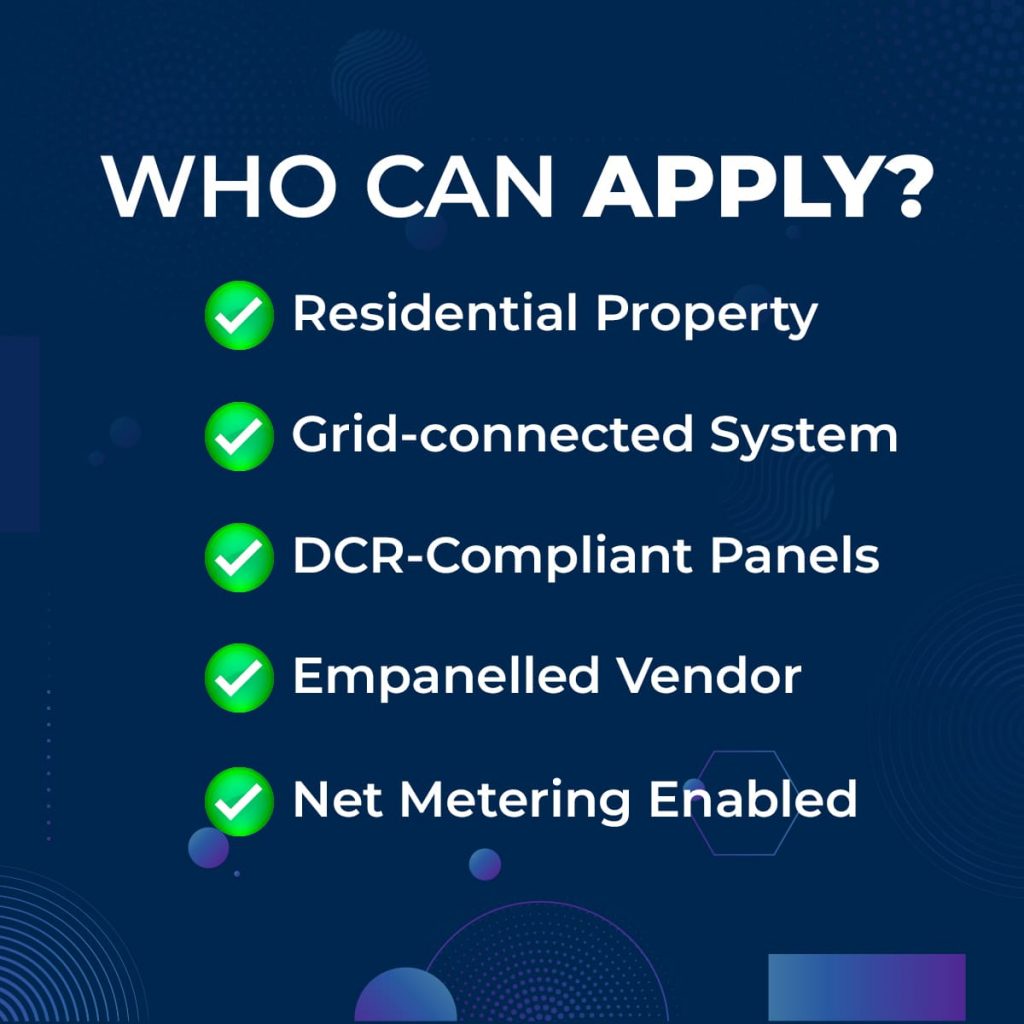
1. System Type
- Only grid connected PV systems i.e. on grid solar and hybrid solar systemsare eligible.
- Off-grid systems/battery based standalone systems are not covered under the subsidy scheme.
1. Residential Use Only
- The solar system must be installed exclusively at a residential property.
- Commercial, industrial, and institutional properties are not eligible.
2.Use of DCR (Domestic Content Requirement) Panels
- Only DCR-compliant solar panels (made in India) are allowed.
- Imported or non-DCR panels will disqualify the applicant from receiving the subsidy.
4. Capacity Limits
- The subsidy is applicable for solar systems up to 3 kW (with varying rates up to 10 kW).
- Higher capacities may be allowed but without subsidy beyond the capped limit.
5. Grid Connectivity
- The system must be connected to the local electricity grid.
- Appropriate net metering arrangements must be in place.
6. Vendor Registration
- Installation must be done through an empaneled vendor listed under the scheme.
- Self-installations or unregistered vendors are not eligible for subsidy claims.
7. Proper Documentation
- Applicants must provide valid property ownership proof, Aadhaar, electricity bill, and bank account details linked with Aadhaar.
8. Single Beneficiary Rule
- One household is eligible for subsidy only once under this scheme.

How to Apply for Solar Subsidy under PM Surya Ghar: Muft Bijli Yojana
Getting a subsidy for your rooftop solar system is simple! Just follow these easy steps to register and apply through the official portal:
Step 1: Go to the Official Website
https://pmsuryaghar.gov.inStep 2: Begin Your Application
Once you’re on the homepage:
- Click on the “Apply Now” button on the Consumer page OR
- Open the Login menu at the top and select “Consumer Login”
Step 3: Register with Your Mobile Number
You’ll now need to register using your electricity connection details:
Enter your registered mobile number (linked to your electricity bill)
- Fill in the captcha correctly
- Tick the checkbox to confirm that you’ve read the scheme guidelines
- Click “Verify” to proceed
Step 4: Complete Your Profile
After successful verification and login, you’ll be asked to fill out your basic profile:
- Enter your full name, email ID, address, state, district, and PIN code
- Double-check the details and click “Save”
Step 5: Submit Solar Installation Request
- From your dashboard, go to Apply for Rooftop Solar.
- Fill in your connection details like consumer number, DISCOM name, and sanctioned load.
- Choose your desired solar system capacity (in kW).
- Submit the request for DISCOM approval.
Step 6: Wait for DISCOM Approval
- Your electricity distribution company (DISCOM) will review your request.
- Once approved, you’ll get a Permission Letter via the portal.
- (You can track the status from your dashboard.)
Step 7: Select an Empanelled Vendor
- You can now choose a vendor listed under the scheme for your region.
- The vendor will visit your site, finalize the system, and begin the installation process.
- Note: Make sure the vendor installs DCR-compliant solar panels to remain eligible for subsidy.
Step 8: System Installation & Net Metering
- The vendor will install the solar system and apply for net metering with your DISCOM.
- After successful inspection and meter installation, the system will be activated.
- Your DISCOM will issue a Commissioning Certificate via the portal.
Step 9: Upload Bank Details for Subsidy
- Once you receive the commissioning certificate, log in to your portal again.
- Enter your bank account details and upload a cancelled cheque.
- Submit the final request to claim your subsidy.
🎉 Final Step: Subsidy Credited
- After verification, the subsidy amount will be directly transferred to your bank account under the Direct Benefit Transfer (DBT) scheme.
How to Choose Between On-Grid and Hybrid Solar Systems
Not sure which solar system is right for your home or business? Here’s a quick way to decide:
- Go for an On-Grid Solar System if your area has a stable electricity supply and power cuts happen less than 2 hours in a week. It’s great for saving on electricity bills by feeding extra power back to the grid.
- Choose a Hybrid Solar System if you experience frequent or long power cuts—more than 2 hours per week. A hybrid system comes with a battery backup, so you’ll still have power during outages.
Recover Your Solar Investment in Just a Few Years
The warranty on solar panel goes up to 27 Years of output and 10 years of product warranty Wondering how long it takes to recover the cost of a solar system? Here’s a basic example to help you understand the potential return on investment (ROI):
- Let’s say you install a 3kW On-Grid Solar System
- The typical cost is around ₹2,10,000, but with the government subsidy, you pay roughly ₹1,50,000
- Monthly savings on your electricity bill could be around ₹2,500 to ₹3,000
- At this rate, your system pays for itself in about 4 to 5 years
After the break-even point, your solar system continues to generate free electricity for years—giving you long-term financial benefits.
Disclaimer: This is just a simplified example to give you a basic idea. Actual costs, subsidies, and savings may vary based on your location, electricity
usage, and system configuration. Please consult a certified solar professional for accurate estimates.
Frequently Asked Questions
What’s the biggest reason to go for rooftop solar?
It’s smart economics. A rooftop solar system helps you cut down your electricity bills and provides reliable backup power during outages. You can even earn money by selling extra power back to your electricity provider (DISCOM). It’s savings and income—rolled into one.
How much can I actually save each year?
If your household uses up to 300 units a month, a 3 kW solar system could save you around ₹15,000 every year on your electricity bill. That’s money staying in your pocket month after month.
What if I take a loan to install the solar system? Will I still save?
Absolutely. Even after paying an estimated ₹610 monthly EMI for your solar loan, your savings still come out to around ₹1,265 per month, or nearly ₹15,000 a year.
What is the larger impact of the PM Solar Scheme?
The scheme aims to add 30 GW of solar capacity across households in India. Over 25 years, this could reduce 720
Can I apply for net-metering through the National Portal?
Yes, you can. The National Portal allows users to apply for both net-metering and inspection. A detailed step-by-step guide is available on the portal to help you complete the process smoothly.
Can I install a rooftop solar system if I live in a rented house?
Yes, you can install a solar system in a rented house, but you’ll need a no-objection certificate (NOC) from the property owner. It’s important to have their permission before applying through the portal.
What bank details do I need to submit to receive the subsidy?
After your system is commissioned and the DISCOM submits the report, you’ll need to enter these bank details to claim the subsidy:
- Your full name as per bank records
- Bank account number
- Bank name
- IFSC code
- A scanned copy of a cancelled cheque
Will UTL Solar handle installation too?
Yes, absolutely! We provide full documentation support to make your subsidy claim process smooth and hassle-free. From installation to paperwork—we’re with you at every step.
How long is the warranty period for UTL Solar products?
We stand behind the quality of every product. We offer:
- On-Grid Inverters: 10 years warranty
- Hybrid Inverters: 5 years warranty
- Solar Panels: 27 years performance warranty
You can count on long-term performance and peace of mind.
Get In Touch

